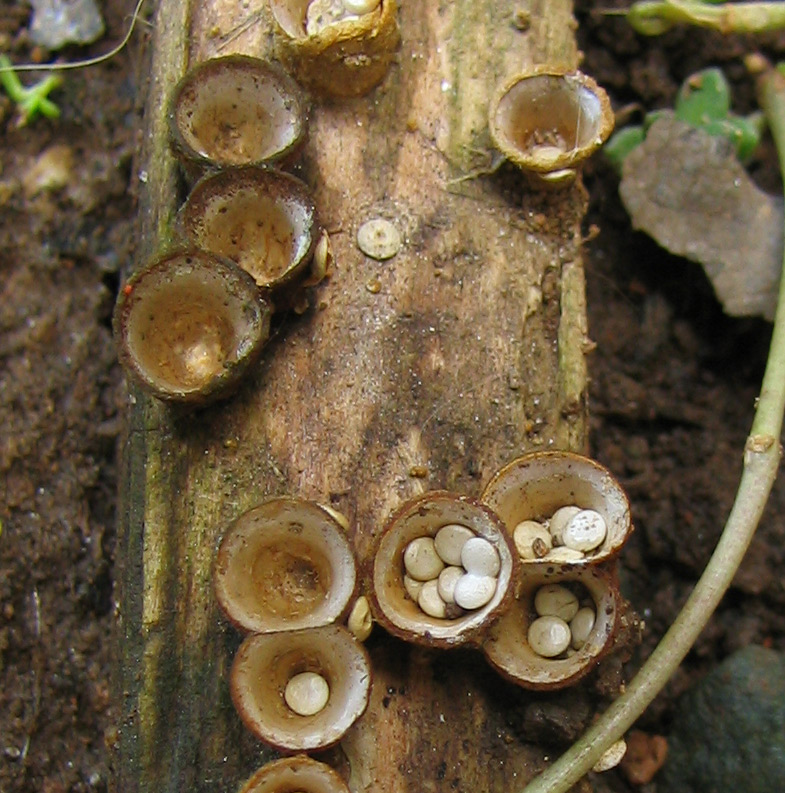Endoperidium on:
[Wikipedia]
[Google]
[Amazon]

 The peridium is the protective layer that encloses a mass of spores in
The peridium is the protective layer that encloses a mass of spores in

 The peridium is the protective layer that encloses a mass of spores in
The peridium is the protective layer that encloses a mass of spores in fungi
A fungus ( : fungi or funguses) is any member of the group of eukaryotic organisms that includes microorganisms such as yeasts and molds, as well as the more familiar mushrooms. These organisms are classified as a kingdom, separately from ...
. This outer covering is a distinctive feature of gasteroid fungi
The gasteroid fungi are a group of fungi in the Basidiomycota. Species were formerly placed in the obsolete class Gasteromycetes Fr. (literally "stomach fungi"), or the equally obsolete order Gasteromycetales Rea, because they produce spores insi ...
.
Description
Depending on the species, the peridium may vary from being paper-thin to thick and rubbery or even hard. Typically, peridia consist of one to three layers. If there is only a single layer, it is called a peridium. If two layers are present, the outer layer is called the exoperidium and the inner layer the endoperidium. If three layers are present, they are the exoperidium, the mesoperidium and the endoperidium. In the simplest subterranean forms, the peridium remains closed until the spores are mature, and even then shows no special arrangement for dehiscence or opening, but has to decay before thespore
In biology, a spore is a unit of sexual or asexual reproduction that may be adapted for dispersal and for survival, often for extended periods of time, in unfavourable conditions. Spores form part of the life cycles of many plants, algae, f ...
s are liberated.
Puffballs
For most fungi, the peridium is ornamented with scales or spines. In species that become raised above ground during their development, generally known as the "puffball
Puffballs are a type of fungus featuring a ball-shaped fruit body that bursts on impact, releasing a cloud of dust-like spores when mature. Puffballs belong to the division Basidiomycota and encompass several genera, including ''Calvatia'', ''Ca ...
s", the peridium is usually differentiated into two or more layers, where the outer layer is usually resolved into warts or spines. In contrast, the inner layer remains continuous and smooth to preserve the spore
In biology, a spore is a unit of sexual or asexual reproduction that may be adapted for dispersal and for survival, often for extended periods of time, in unfavourable conditions. Spores form part of the life cycles of many plants, algae, f ...
s. Sometimes, as in the case of ''Geaster
''Geastrum'' (orthographical variant ''Geaster'') is a genus of puffball-like mushrooms in the family Geastraceae. Many species are known commonly as earthstars.
The name, which comes from ''geo'' meaning ''earth'' and meaning ''star'', refers ...
'', the number of layers is greater, and the exoperidium eventually splits from the apex into a variable number of pointed portions. However, the inner layer remains intact by a definite aperture
In optics, an aperture is a hole or an opening through which light travels. More specifically, the aperture and focal length of an optical system determine the cone angle of a bundle of rays that come to a focus in the image plane.
An opt ...
at the apex.
Earthballs
In contrast,earthball
''Scleroderma'' is a genus of fungi, commonly known as earth balls, now known to belong to the Boletales order, in suborder Sclerodermatineae. The best known species are '' S. citrinum'' and '' S. verrucosum''. They are found worldwide.
V ...
fungi generally have only one peridium, which is 3–9 cm across. This lone peridium is generally rigid and rindlike; it is white when sectioned but pink if fresh. The surface varies from yellow brown to dingy yellow, and is arranged into scales.
Usage
The peridium is often given a specific name in particular species offungi
A fungus ( : fungi or funguses) is any member of the group of eukaryotic organisms that includes microorganisms such as yeasts and molds, as well as the more familiar mushrooms. These organisms are classified as a kingdom, separately from ...
. For example, the peridium of the sub-family Phalloideae is called a volva. The peridium can also refer to the outer "nest" of a bird's-nest fungus.''Botany Illustrated: Introduction to Plants, Major Groups, Flowering Plant Families''; By Janice Glimn-Lacy, Peter B. Kaufman; page 53; Published by Birkhäuser, 2006; ,
References
{{Reflist Fungal morphology and anatomy